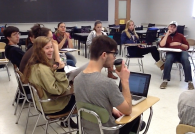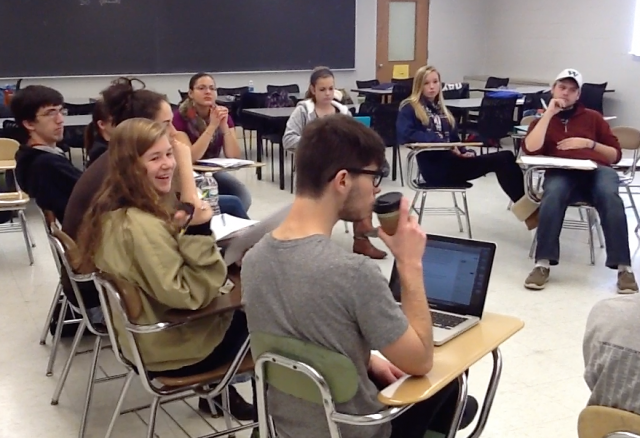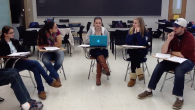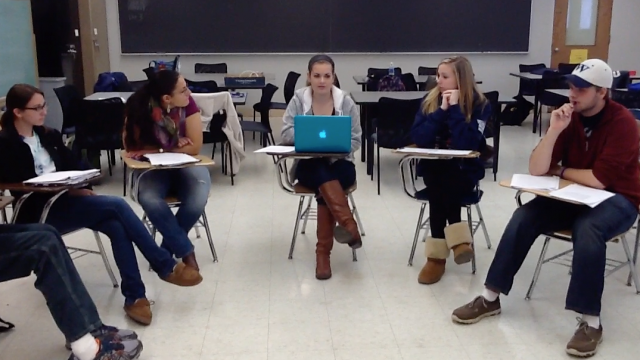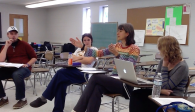Peer Review
Written by: Dr. Christine von Renesse
Can we use peer review to improve proof writing in mathematics classes?
Twice now I had the pleasure of teaching a learning community with an English composition class. And each time I was impressed by the peer review process that my colleague Jen DiGrazia used for all student papers.
Composition Peer Review:
The class would sit in a circle and one student would volunteer to read his or her paper. The audience was taking notes of anything that
stood out to them or any questions that came up. Afterwards there was a strict protocol how to respond to the author: You don’t evaluate at all but instead state the main message you heard, point to phrases that stood to you, ask questions, say what you would have liked to hear more of and check if all requirements are fulfilled. The author was not allowed to respond to anything but could ask questions after the audience was done with their feedback. The energy during the peer review was relaxed but focused at the same time.
If the students struggled with their language and started saying “I liked…” the professor stepped in to remind them to not evaluate but use phrases like “I noticed that…”, “I wonder why…” etc.
Composition Peer Review Protocol
- Sayback: What overall point do you hear the writer making? What are they almost saying?
- Pointing: Which parts (words, phrases, ideas, sections) stood out to you? What will you remember from this paper?
- Questions: What did you want to know more about? What was confusing to you? What questions occurred to you as you heard/read this paper?
- Assignment Criteria
- Author Questions
After the "model" peer review with the whole class, students would meet in small groups to peer review each other's papers. The professor circled around or stayed with a particular group for a while to listen in. In the end every student had received (and given) peer feedback.
Student Reflection, Fall 2014:
I got to see how they (Math and Composition) connected more towards the end of the semester when we tried to peer-review a math proof. Then it started to click in my brain that you have to be a good precise writer to be a mathematician.
Math Peer Review
It took us a while to find a similar process for peer reviewing proofs in mathematics. It seemed impossible for me to have students “judge” the mathematical reasoning of other students since most of them were lost themselves! Don’t they need my feedback more than anything else? Then we had the insight that the whole class could work together on improving a proof attempt using specific questions that required them to think about the writing in connection with the mathematics.
In fall 2013 we let the students peer review their math project papers, which were quite intensive in length and depth. We used a slightly adapted version of the composition protocol for peer review (see above). The following video shows an excerpt:
While the peer review was productive the feedback was not addressing the deeper mathematical issues of the papers. The problem was that the audience did not have the same knowledge about the material as the presenter and often could not really follow the mathematical thinking. I spent a lot of time thinking about peer review in mathematics in the year after and talked to several colleagues in the English department. In fall 2014 Jen and I tried an adapted format of peer review which we only used for a relatively short mathematical argument (instead of a larger project paper):
I asked for a volunteer for the peer review but made sure that the volunteer’s work was something “worth reviewing” (i.e. not too good and not too bad). Then the students sat in groups as they always do, each with a copy of the proof to be peer reviewed. The author of the proof read his or her proof to the class who could read along. Afterwards the groups had time to “digest” the proof, thinking about the details and maybe writing up some questions. Next we went through the prompts in a whole class discussion. (See our whole class discussion blog to learn more about how to facilitate such a discussion.) Often I gave time to the groups to think about an aspect or to improve a particular sentence or paragraph. We would then share out the improved versions and as a class pick what we considered best.
After the whole class peer review the students repeated the process in their groups to work on their own proofs.
Math Peer Review Protocol
There are some prompts that are more geared towards the general writing style, like:
- Audience:
Who seems to be the intended audience? What suggests that to you? What is this audience's interest in the proof? Why might they care? Do you have ideas about how the writer might shift language and structure (and ideas?) to more effectively address this audience? - Introduction: Does the writer offer an overview that outlines the problem? Does the writer explain what s/he will do, and why? Does the writer give some context for the problem and the proof? Do you have ideas about what the intro might do that it doesn't, or what the writer might do differently?
- Process: Did you get a sense of how the writer arrived at his/her proof? What process did s/he follow? Do you want a better sense of that process? Where and how might the writer incorporate that?
But then we found several additional prompts that really helped the students dig into the mathematical content, and the representation of the proof:
- Statement/Conjecture: Restate the conjecture that you hear or that you almost hear. Are there ways you might suggest that the writer re-shape and re-state his/her conjecture? Why?
- Specificity/Conciseness: Choose 1-2 sentences that seem "bulky" or less clear. As a group, re-work the sentences, paying particular attention to: use of pronouns (is the antecedent clear), double negatives, active verbs (watch for 'ing" verbs and "would" verbs) and clear connections between the agent of the sentence and the action of the sentence.
- Transitions: Are you able to follow the logic of the proof? What connections is the writer making between ideas? Would repetition of the previous concept/term help to clarify? How about a transitional phrase or term?
- Complete Proof: Would you call this proof "complete"? Why/why not? What would you like to see developed?
- Holes: Do you see any gaps in the writer's reasoning or ideas? Are there concepts or ideas or connections that you think could be clarified or strengthened?
- Images to help the reader if applicable: How does the writer use graphics or images? What are these graphics or images being used to do? Is it clear how the graphics/images work with the text? Would you like more or fewer graphics/images? Why? Do you have ideas about how the writer might tighten the connection between the images/graphics and the written text?
The students really liked the process and all of them felt much more prepared to improve their current proofs. It was surprising to me that the improvements they came up with felt so much more meaningful to the students than when I would grade their work giving them the same suggestions for improvement. But then again it is not really that surprising: students have to discover themselves what is not working yet in a proof and develop a desire to improve their work.
You can download the prompts here .
Student Reflection, Fall 2014:
In math class, we did a peer review exercise that we typically do in English, but in this case, it was applied to a proof instead of an essay. Personally, this exercise was extraordinarily helpful, as it forced us to view our proofs from a different perspective and gave us a way to “get out of our own heads” so to speak. This was definitely something with which I struggled at the beginning of the year, especially when I was trying to write up my proof for the 3a+5b problem. In my head, I was confident that I understood what was going on, but when it came to writing that down in an explanation, that confidence fell short. Suggestions and constructive criticism such as “I know you understand it, but you need to work on your wording and explanations” and “be more precise here” were among the feedback that I received for this proof. Had we done the peer review exercise sooner, I may have been able to more clearly recognize my shortcomings and use that peer review as a way to go over my work from the perspective of an outsider who can’t read my mind or know anything about my brain activity.
Using peer review in mathematics also introduces students to the idea of a larger mathematical community. How does the community evaluate whether a proof is correct and worth publishing? Watching the video: “The Proof” could be a nice supplement here to see just how peer review takes place in a world-wide circle of mathematicians.
Constructing Viable Arguments and Critiquing the Reasoning of Others
Recently Volker and I worked with the Mohawk middle and high school on evaluating their students’ ability in “Constructing Viable Arguments and Critiquing the Reasoning of Others“ (Common Core Standard for Mathematical Practice #3). They had developed a very interesting task for their students, first solving a mathematical problem and then analyzing somebody else's work on the same problem. These are their analysis prompts:
- Read through and paraphrase (explain) Santos' argument in your own words.
- Find where Santos has flaws in his reasoning.
- Write down any questions you would ask him to clarify his approach to this problem.
Since I was thinking about peer review I noticed how the review part of the assignment is really a wonderful practice/assessment of peer review! Or maybe peer review is a way to practice what the practice standards ask us to accomplish? Anyway, the connection is obvious. I would really love to create problems like this in my college classes (especially calculus) and will work on improving my investigations and assignments (maybe even exams?) to include prompts like this.
Peer review and IBL
First of all I don’t think it would be possible to do the above peer review process in a traditional lecture classroom. It requires that students feel comfortable and safe working with each other, realizing the value in making mistakes and seeing mathematics as something they can take ownership in.
As mentioned above students discover themselves during the peer review how to improve their mathematical reasoning and writing. Of course the professor still does the grading - but the students are taking an active part in the evaluating, and improving process now. The professor is a bit less of a “sage on stage”, he or she is part of the peer reviewing team with a purpose of improving instead of judging.
Student Reflection, Fall 2014:
Writing skills are just as important in Math as they are in English. When I got stuck or thought my thinking wasn’t sound enough, I looked for help from my peers and my teachers. They encouraged me to persevere and gave me the tools or the knowledge to do so.
I’ve learned that taking the time to edit, having peer or teacher input, using inductive and deductive reasoning, and enduring through obstacles are all essential things to do to improve my writing process.

